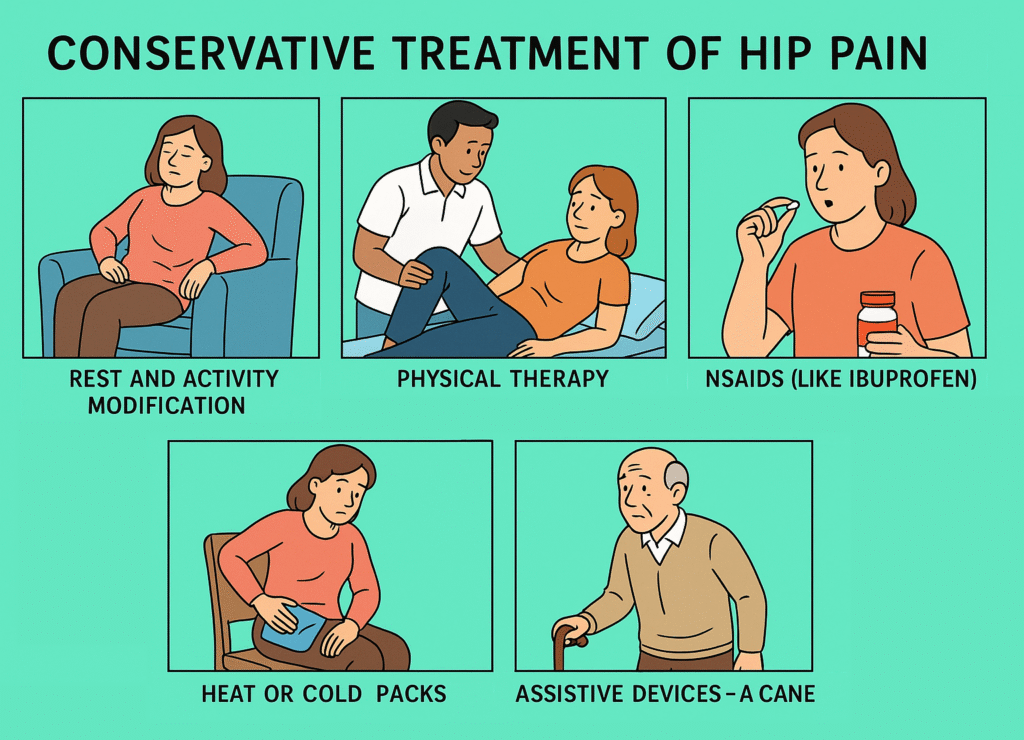Hip pain can slow you down, make walking uncomfortable, and turn everyday movements into a challenge. Whether it strikes suddenly or builds up over time, hip pain can have many causes—from minor injuries to chronic conditions. But don’t worry—understanding what’s behind the pain is the first step toward finding relief.
What Is Hip Pain?
Hip pain refers to discomfort felt around the hip joint, which is where your thigh bone (femur) meets the pelvis. It might be felt in the front of the hip, deep in the groin, on the outer hip, or even radiate down the thigh.
It’s a common complaint—especially in older adults—but it can affect people of all ages. According to studies, around 14% of adults over 60 report significant hip pain during daily activities.
How Does It Happen?
Think of your hip joint like a ball-and-socket system. The femoral head (the “ball”) fits neatly into the acetabulum of the pelvis (the “socket”), allowing smooth rotation and movement. Cartilage covers the surfaces, acting like a cushion and reducing friction.
Now, imagine what happens when:
- That cartilage wears down (like a worn-out cushion).
- The joint becomes inflamed.
- Muscles, tendons, or bursae around the hip get irritated or torn.
All of these can trigger pain. The body tries to compensate by shifting how we move—sometimes causing more strain and more discomfort.
What Causes Hip Pain?
Hip pain can come from a wide range of causes, depending on your age, lifestyle, and health. Here are some of the most common culprits:
- Osteoarthritis – The leading cause, especially in people over 50. This is due to wear and tear of the cartilage. Affects around 1 in 4 adults at some point.
- Bursitis – Inflammation of small fluid-filled sacs (bursae) that cushion the joint. It causes sharp pain, especially when lying on your side.
- Tendonitis – Overuse of muscles like the iliopsoas or gluteus medius can inflame tendons, leading to aching pain during activity.
- Hip Labral Tear – A tear in the cartilage ring (labrum) that supports the joint. Often seen in athletes or after trauma.
- Fractures – More common in older adults, especially those with osteoporosis. Sudden, severe pain after a fall could be a red flag.
- Muscle strain – Overstretching or injury to hip flexors or hamstrings.
- Inflammatory diseases – Conditions like rheumatoid arthritis or lupus can also affect the hip.
- Referred pain – Sometimes, hip pain doesn’t even start at the hip. Back or pelvic issues may send pain signals to the hip area.
Who’s Most at Risk?
Hip pain doesn’t play favourites, but some people are more likely to deal with it than others. If you fit into any of these categories, you might want to be extra mindful of your hips.
- Older adults – Cartilage naturally wears out with age.
- Athletes – Runners, dancers, and footballers often stress their hip joints.
- People with obesity – Extra weight increases joint stress.
- Those with previous hip injuries – Old fractures or dislocations can lead to arthritis.
- Family history of arthritis – Genetics play a role in joint health.
Other Symptoms That Come With Hip Pain
Pain isn’t the only signal your hip sends out when something’s wrong. Other signs include:
- Stiffness – Especially in the morning or after sitting for long.
- Clicking or popping – Sometimes painless, sometimes sharp.
- Swelling or warmth – A sign of inflammation or infection.
- Limited movement – Trouble bending, standing, or rotating the leg.
- Limping – Your body’s natural reaction to avoid pressure on the sore side.
As conditions worsen, some people feel pain even when resting or sleeping on the affected side.
Tests to Identify the Cause
To get to the bottom of hip pain, your doctor may begin with a physical examination—checking your range of motion, strength, and tenderness.
But the gold standard for identifying joint damage is:
Imaging Studies
- X-rays – Useful for spotting arthritis, fractures, or bone alignment.
- MRI – Shows soft tissues, such as labrum tears, tendons, and bursae.
- Ultrasound – Helps evaluate bursitis or tendonitis.
- CT scan – Sometimes used for detailed bone assessment, especially pre-surgery.
In certain cases, blood tests might be ordered to rule out infection or autoimmune diseases.
Treatment for Hip Pain
Managing hip pain depends on what’s causing it. Most cases improve with a combination of rest, medication, and physical therapy—but severe damage may require surgery.
Conservative Management
- Rest and activity modification – Avoid high-impact activities like running.
- Physical therapy – Strengthening and stretching the surrounding muscles.
- NSAIDs (like ibuprofen) – Reduce inflammation and ease pain.
- Heat or cold packs – Help soothe soreness or stiffness.
- Assistive devices – A cane or shoe insert can reduce strain.

Other Treatment Options
- Corticosteroid injections – Provide short-term relief from inflammation.
- Hyaluronic acid injections – Less common, used to lubricate joints.
- Surgery:
- Arthroscopy – Minimally invasive repair of labral tears or loose bodies.
- Hip replacement – For severe arthritis or fractures.
The goal is always to restore function, reduce pain, and prevent further damage.
Final Thoughts
Hip pain isn’t just an annoyance—it can steal your mobility, disrupt your sleep, and limit your daily life. But the good news? With proper diagnosis and tailored treatment, most people find real relief.
So, if that ache in your hip keeps coming back, don’t shrug it off. It might be your body’s way of asking for help—and the sooner you listen, the sooner you can get back to moving freely again.
References
- “Hip Pain: Causes and Treatments”, Mayo Clinic, 2023. https://www.mayoclinic.org/symptoms/hip-pain/basics/definition/sym-20050684
- “Hip Pain”, American Academy of Orthopaedic Surgeons, 2023. https://orthoinfo.aaos.org/en/diseases–conditions/hip-pain/
- “Prevalence and Risk Factors of Hip Pain in Adults”, Journal of Orthopaedic Research, 2020. https://onlinelibrary.wiley.com/doi/10.1002/jor.24651
